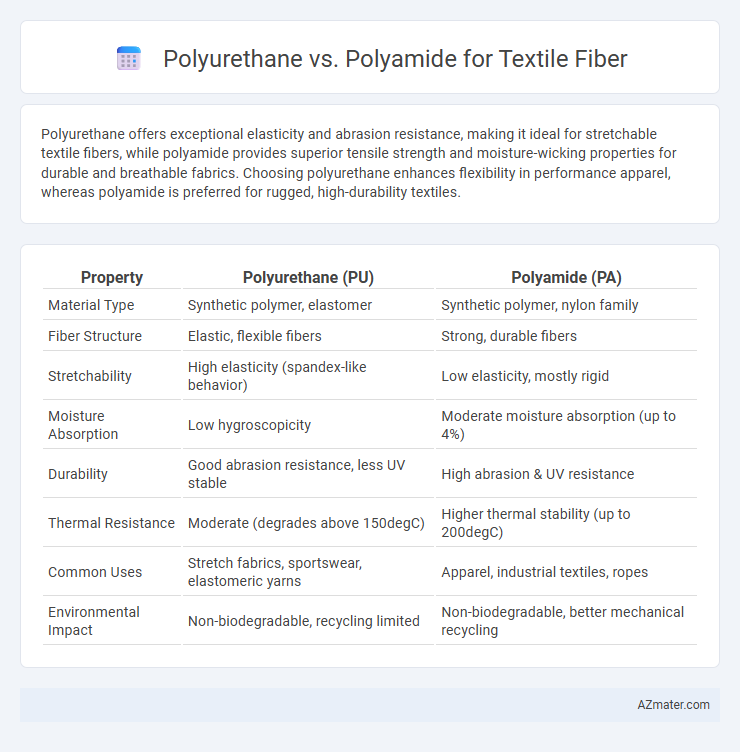Polyurethane offers exceptional elasticity and abrasion resistance, making it ideal for stretchable textile fibers, while polyamide provides superior tensile strength and moisture-wicking properties for durable and breathable fabrics. Choosing polyurethane enhances flexibility in performance apparel, whereas polyamide is preferred for rugged, high-durability textiles.
Table of Comparison
| Property | Polyurethane (PU) | Polyamide (PA) |
|---|---|---|
| Material Type | Synthetic polymer, elastomer | Synthetic polymer, nylon family |
| Fiber Structure | Elastic, flexible fibers | Strong, durable fibers |
| Stretchability | High elasticity (spandex-like behavior) | Low elasticity, mostly rigid |
| Moisture Absorption | Low hygroscopicity | Moderate moisture absorption (up to 4%) |
| Durability | Good abrasion resistance, less UV stable | High abrasion & UV resistance |
| Thermal Resistance | Moderate (degrades above 150degC) | Higher thermal stability (up to 200degC) |
| Common Uses | Stretch fabrics, sportswear, elastomeric yarns | Apparel, industrial textiles, ropes |
| Environmental Impact | Non-biodegradable, recycling limited | Non-biodegradable, better mechanical recycling |
Introduction to Polyurethane and Polyamide Fibers
Polyurethane fibers are elastic, durable synthetic fibers known for their exceptional flexibility and resistance to abrasion, making them ideal for stretchable fabrics in sportswear and hosiery. Polyamide fibers, commonly known as nylon, offer high strength, excellent abrasion resistance, and moisture-wicking properties, widely used in apparel, technical textiles, and industrial applications. Both fibers contribute significantly to textile innovation, with polyurethane providing superior elasticity while polyamide ensures strength and durability.
Chemical Structure and Composition
Polyurethane fibers are composed of long chains of organic units linked by urethane bonds, derived from the reaction between diisocyanates and polyols, which provide excellent elasticity and abrasion resistance. Polyamide fibers, commonly known as nylon, consist of repeating amide groups formed through polycondensation of diamines and dicarboxylic acids, resulting in strong hydrogen bonding that imparts high tensile strength and durability. The key chemical distinction lies in polyurethane's urethane linkage versus polyamide's amide linkage, influencing their mechanical properties and suitability for different textile applications.
Manufacturing Processes
Polyurethane fiber manufacturing involves a solution or melt spinning process, where thermoplastic polyurethane is dissolved or melted and then extruded through spinnerets to form continuous filaments, enabling high elasticity and durability in textiles. Polyamide fibers, commonly known as nylon, are produced through melt spinning of polyamide polymers followed by drawing to align molecular chains, resulting in strong, abrasion-resistant fibers suitable for performance textiles. Both processes require precise control of temperature and extrusion speed to optimize fiber properties, but polyurethane typically offers greater flexibility while polyamide excels in tensile strength.
Physical and Mechanical Properties
Polyurethane fibers exhibit superior elasticity, excellent abrasion resistance, and high tensile strength, making them ideal for stretchable and durable textiles. Polyamide fibers, commonly known as nylon, provide outstanding toughness, moisture-wicking abilities, and resistance to wear and chemicals, contributing to robust and versatile fabric applications. The choice between polyurethane and polyamide depends on specific performance requirements, with polyurethane offering enhanced flexibility and polyamide delivering greater structural strength.
Comfort and Wearability
Polyurethane fibers, known for their exceptional elasticity and stretch recovery, provide superior comfort by allowing fabrics to conform closely to the body while maintaining shape over time. Polyamide fibers offer high durability and moisture-wicking properties, enhancing wearability by keeping the wearer dry and comfortable during extended use. The choice between polyurethane and polyamide depends on the specific textile application, balancing the need for flexibility and comfort with strength and breathability.
Durability and Longevity
Polyurethane fibers exhibit exceptional elasticity and abrasion resistance, making them highly durable and ideal for stretchable textile applications. Polyamide fibers, known for their high tensile strength and resilience to wear, deliver superior longevity in textiles exposed to frequent friction and mechanical stress. Both materials offer strong durability, but polyamide generally provides enhanced long-term performance in harsh environments.
Application in Textile Industry
Polyurethane fibers are widely used in the textile industry for their exceptional elasticity and flexibility, making them ideal for activewear, swimwear, and hosiery. Polyamide fibers, commonly known as nylon, offer high tensile strength, abrasion resistance, and moisture-wicking properties, making them suitable for performance sportswear, outdoor apparel, and intimate garments. The choice between polyurethane and polyamide depends on the balance of stretch, durability, and comfort required for specific textile applications.
Environmental Impact and Sustainability
Polyurethane fibers often pose greater environmental challenges due to their reliance on non-renewable petroleum-based raw materials and energy-intensive production processes, contributing to higher carbon footprints. Polyamide fibers, while also petrochemical-derived, benefit from advancements in recycling technologies and producers' efforts in developing bio-based alternatives that reduce ecological impact. Sustainable textile initiatives emphasize polyamide's recyclability and lower greenhouse gas emissions, positioning it as a more eco-friendly choice compared to conventional polyurethane fibers.
Cost Comparison and Market Trends
Polyurethane fibers generally cost more than polyamide fibers due to their complex manufacturing processes and specialized applications in stretch and performance textiles. Polyamide, commonly known as nylon, remains the dominant choice in the textile market because of its affordability, durability, and versatility across apparel and industrial uses. Market trends indicate growing demand for polyurethane in high-performance activewear and medical textiles, while polyamide maintains strong growth driven by its cost-effectiveness and broad adoption in mass-market clothing.
Conclusion: Choosing the Right Fiber
Polyamide offers superior strength, abrasion resistance, and moisture-wicking properties, making it ideal for durable, high-performance textiles. Polyurethane excels in elasticity and flexibility, providing exceptional stretch and recovery for comfort-focused applications like activewear. Selecting the right fiber depends on balancing durability and elasticity requirements specific to the textile's end use.

Infographic: Polyurethane vs Polyamide for Textile Fiber
 azmater.com
azmater.com